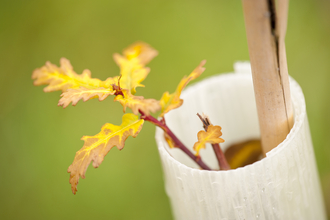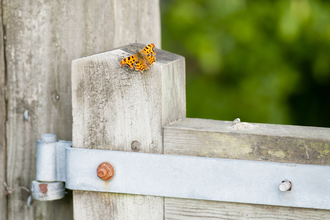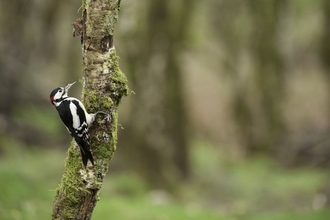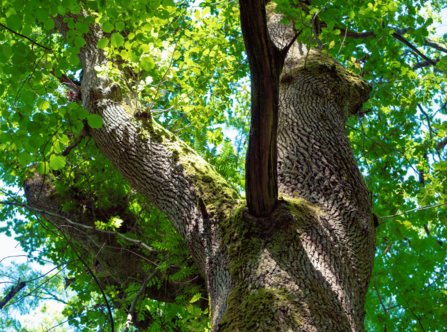Woodland Recovery Appeal
Woodlands near you are at risk
Woodland habitats are home to some of Dorset’s most spectacular wildlife species. But they are under attack from many directions:
Ash dieback has already infected 90% of Dorset's ash trees. Most of these will die.
Fragmentation over many decades has left Dorset's woodland habitats disconnected and diminished, so wildlife doesn't have room to move and spread.
Climate change threatens to plunge woodlands into unfamiliar and deadly conditions. Flooding, wild fires, extreme temperatures and new plant diseases could devastate Dorset's trees and wildlife.
We need to give this vital habitat, and the thousands of species that rely on it, a more secure future - but we can't do it without your support.
Your donation will make a difference

£50
could pay for 10 young native trees, grown and cared for until established
£150
can buy 10 metres of fencing to protect young trees from deer
£250
helps create new woodland using rewilding techniquesHow your donation will protect and maintain woodlands
Regenerating woodlands
Your support will power restoration in Dorset's woodlands, through traditional management techniques as well as natural regeneration. This allows existing trees to self-seed while natural protectors like brambles keep saplings safe until they can protect themselves from nibbling and trampling by wildlife. But there are still significant costs involved. Targeted conservation grazing can boost biodiversity and requires careful management, while preventing deer damage to young trees can be costly at around £150 for every 10 metres.
Expanding woodlands
Creating more woodland habitat means acquiring land. That's especially important where we can reconnect existing wooded areas, fighting back against fragmentation. Wildlife needs space to move freely, particularly as Dorset’s woodlands change because of ash dieback and global warming.
We need to plant trees sensitively on appropriate land, using native species for the biggest biodiversity gains. But expanding woodlands is expensive: it costs over £10,000 to create just one acre of emerging woodland, which includes three years of management to ensure it is properly established.
Managing woodlands for resilience
Coppicing and establishing rides and glades in woodlands create a succession of habitats to aid biodiversity. More light enters, meaning more varied plant life grows on the woodland floor. This time-consuming and physical - but essential - work is carried out on reserves by trained wardens and dedicated volunteers using expensive tools that require regular maintenance.
Working with partners
Through partnerships, we can make more space for wildlife, creating nature recovery networks across the county. We will continue to build strong relationships with the people and organisations whose land borders ours. We work with these landowners to ensure their space is as wildlife-friendly as possible and that mature trees are protected.
Why we must act now
Ash dieback
Ash dieback is an incurable fungal disease which causes infected ash trees to wither and die. It forces landowners, including Dorset Wildlife Trust, to fell or coppice trees where falling branches might endanger the public. Woodpeckers, nuthatches and owls nest in holes in mature ash trees. Their leaves provide food for many caterpillars, including the beautiful privet hawk-moth.
Next to roads, public rights of way and neighbouring properties, ash trees must be safely felled before they can pose a danger. This work is essential but strikes a devastating blow to our efforts to increase biodiversity across Dorset. The cost of managing these dying ash trees is high – at least £30,000 each year – and this will only increase as more degrade and pose a danger to walkers or drivers.
Fragmentation
Decades of development and human activity have reduced previously large areas of woodland to disconnected pockets. This not only limits the overall amount of wildlife our woodlands can support, but also leaves nesting birds, mammals and insects trapped within the confines of their isolated woodland habitats, with nowhere to turn if the conditions change.
To combat this, we need to expand Dorset Wildlife Trust woodlands in order to expand the populations they can support, through natural regeneration and planting native trees where appropriate. We also need to acquire new land, particularly where we have the opportunity to reconnect existing woodlands and give wildlife much more space.
Climate change
Climate change is now very much happening here in Dorset, with record high temperatures recorded each summer and more extreme weather in winter. In the future we expect to see more flooding, wildfires and plant diseases as a result of the changing climate. Woodland ecosystems did not evolve in these conditions and we can't yet know exactly how they will react over many years of unfamiliar conditions. Therefore, it's more important than ever that wildlife has space to move and that woodlands are managed for resilience, to give them the best possible chance at thriving.

Trees provide us with comfort and hope in the face of an uncertain future (credit: James Burland/Dorset Wildlife Trust)
Nature reserve case studies
Your donation will contribute to vital work restoring and expanding woodlands across Dorset. Here are just a few of the nature reserves where your support will make a huge difference.
Bracketts Coppice, Halstock
Dormice, otters and woodpeckers nestle in the varied habitat at Bracketts Coppice. Ancient woodland, hazel coppice, meadows and streams make this nature reserve a true haven for wildlife, as well as a magical place to visit.
Your donation will help ensure that woodland management and regeneration can continue here. Insects and birds benefit from the sensitive creation of glades and woodland rides, while the infected ash in the woodland here will need to be managed and replaced though natural regeneration or planting.
Powerstock Common, Toller Porcorum
The mosaic of habitats at Powerstock Common includes woodland, alive with fruit and fungi in autumn. Woodland edges are perfect for foraging lesser horseshoe bats, feasting on the insects that make up the diet of this declining species.
This mix of habitats including woodland is vital to supporting bats and so much more wildlife that needs our help to recover. Woodland expansion and regeneration will help ensure this habitat is resilient against the loss of ash trees to dieback and the changes such as extreme heat and plant diseases already taking effect due to climate change.
Ashley Wood, Blandford Forum
Dorset Wildlife Trust acquired Ashley Wood in 1999 and reinstated traditional woodland management through sensitive coppicing. This has created a varied woodland structure with wide sunny rides, perfect for butterflies such as speckled wood, white admiral and silver-washed fritillary.
The high proportion of ash in the woodland means an uncertain future, with ash dieback infection slowly killing the vast majority of ash trees in Dorset. Natural regeneration, sensitive planting and careful traditional management paid for by your donation will give this woodland its best chance of thriving in the decades to come.




